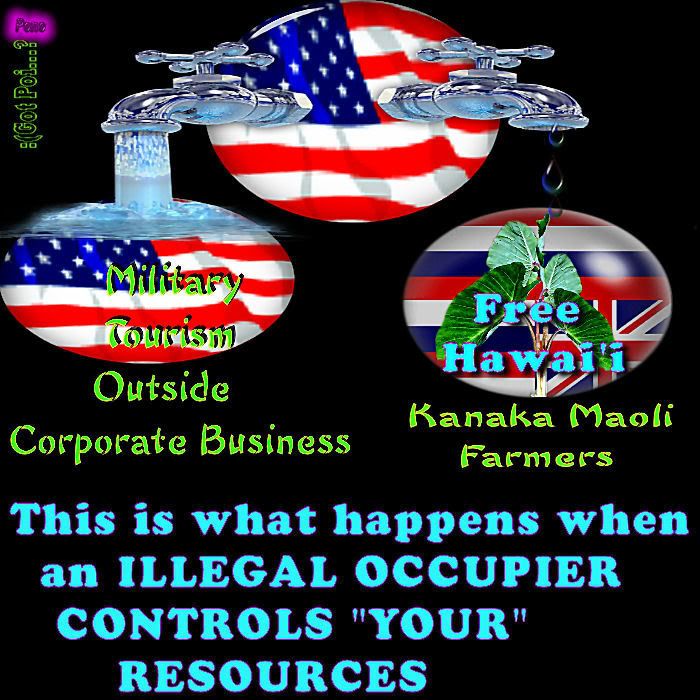 Star Bulletin - "Water worries sugar workers"
Star Bulletin - "Water worries sugar workers"Hawaiian Commercial & Sugar Co. has been diverting every drop of water out of the East Maui watershed, over 100 streams for over 100 years. The employees are worried about their jobs, but their employer has had no compassion for the hundreds of farmers who were forced to abandon their lo`i lands because of the massive dewatering, abusive practices that have been going on for many decades. We need balance here. The time is past when agribusiness can be allowed to ignore and run roughshod over constitutionally protected rights. HC&S has been a bad corporate citizen in so many ways, its unprofitable operations propped up by millions of taxpayer dollars in federal subsidies and exemptions from environmental laws to keep it afloat. HC&S needs to account to the public for its ongoing noxious activities -- cane burning that blankets Paia and Kahului households and businesses, permissible only because of exemptions from environmental laws; and robbing the people of water on such a massive scale as to be one of the largest, if not the largest, private diversions in the U.S. -- permissible only because of the state's heretofore reluctance to enforce the law. We need to support the Commission on Water Resources Mangement (CWRM) in its efforts to the right thing, to do its job after decades of complicity and negligence on the part of this state of Hawaii.
xxx Mahealani
...........................................................
Water worries sugar workers
HC&S employees are opposed to a state commission's plan for stream flow on Maui
By Allison Schaefers
POSTED: 01:30 a.m. HST, Oct 09, 2009
Union employees at Hawaiian Commercial & Sugar Co., soon to be Hawaii's last sugar company, have formed a group to ensure water from the East and West Maui streams is available for irrigation.
Members of Hui o Ka'Ike held a news conference yesterday at HC&S seeking help to stop the state Commission on Water Resource Management from passing a recommendation that returns 50 percent of diverted water to the Waihee River and three streams.
Willie Kennison, Maui division director for the International Longshore and Warehouse Union, said the recommendation would set a precedent influencing East Maui's stream management.
Commissioners will hear final arguments on West Maui's stream use during a contested case hearing at 9 a.m. on Thursday at Iao Congregational Church. While public comments will not be allowed at the morning hearing, comments will be taken later that day at Paia Community Center during a 5 p.m. fact-finding meeting on water management of 19 streams in East Maui.
"Our main concern is receiving a sufficient amount of water so that HC&S can remain a viable company," said Kelly Ruidas, a 12-year employee of HC&S. "The economic impact would extend past HC&S' 800 employees to the many Maui businesses that rely on all of us for their survival."
HC&S union members and management are united in their efforts to stop Commissioner Lawrence Miike's recommendation from advancing, Kennison said. However, another group, Hui o Na Wai Eha, has been just as vigilant in its efforts to restore water to the mouth of the Waihee River and the Iao, Waiehu and Waikapu streams. Na Wai Eha means the four waters.
The environmentalists, taro farmers and residents who make up Hui o Na Wai Eha say that dry streams disturb the region's natural environment, impede farming and harm nearby wildlife. Earthjustice filed a 2004 petition to force major water users like HC&S and the Wailuku Water Co. to restore the streams.
About 100 supporters marched last Friday to draw attention to the upcoming case, said Earthjustice attorney Isaac Moriwake.
"This will determine Maui's water future for decades to come," he said. Off-stream diverters have a responsibility to steward resources, he said.
Allen Doane, chief executive officer of Alexander & Baldwin, of which HC&S is a division, said earlier that the company is striving to improve its subsidiary's performance and expects to decide HC&S' future by year's end. A lot will ride on water supply, Kennison said.
"They can't continue to operate if they don't divert the water because there simply isn't enough rainfall," he said.
Moriwake countered that HC&S and the Wailuku Water Co. have alternatives, such as pumping nonpotable wells, that avoid stream diversion. "The big diverters take everything and leave the public with a trickle," he said.
Union employees at Hawaiian Commercial & Sugar Co., soon to be Hawaii's last sugar company, have formed a group to ensure water from the East and West Maui streams is available for irrigation.
East Maui Water Rights Part 1 Ed WendtEast Maui Water Rights Part 1 Ed Wendt. Produced by Wendy Osher and Frank W Pulaski III Written by Wendy Osher Camera and Edited by Frank W Pulaski IIIEast Maui Water Rights Part 2 Bush Martin and Terry AkunaEast Maui Water Rights Part 2 Bush Martin and Terry Akuna Produced by Wendy Osher and Frank W Pulaski III Written by Wendy Osher Camera and Edited by Frank W Pulaski IIIEast Maui Water Rights Part 3 Landmark DecisionEast Maui Water Rights Part 3 Landmark Decision Produced by Wendy Osher and Frank W Pulaski III Written by Wendy Osher Camera and Edited by Frank W Pulaski IIIMaui Water 21Mar07 part 1Isaac Moriwake, an Earthjustice attorney, explains the results of the Waiahole case on March 21, 2007, on Maui


Comments